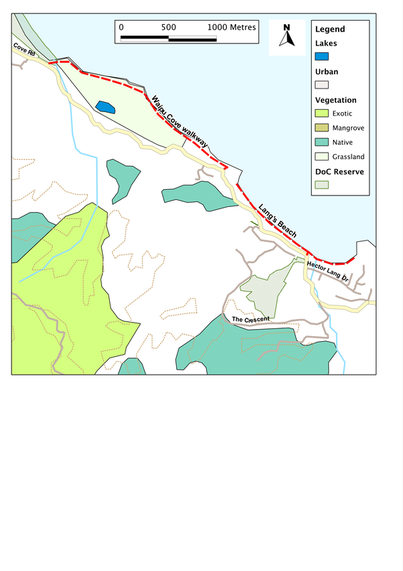SummaryLocation: Waipu Cove, 8 km south of Waipu.
Access: Carpark on Waipu Cove Road at south end of Waipu Cove. Length: ca. 3 km (one-way) Configuration: There-and-back (or loop via Waipu Cove Road) Grade: Undulating, with some short scrambles; unmade path. Status: on leash on private land (with off-leash sections along beasches) Cafes and restaurants: Cove Cafe, opposite carpark in Waipu Cove; Beach House restaurant, Waipu Cove (ca.100 metres) More information: |
DescriptionThe Waipu Cove Walkway has been developed and is maintained by local volunteers - and they deserve every credit for what they've achieved. While the walk can be a bit of a scramble in places, it's worth the effort, for it takes in a lovely stretch of coastline, with gorgeous coves, some great views out to sea, and some interesting geological features to explore on the way.
The usual entry point is from the carpark at Waipu Cove; there's no parking available at the other end. Depending on the tide and the recent weather, the start can be a bit of an adventure, for it involves crossing the small stream at the southern end of the beach. We can often splash through, or jump across, but at times the water's just a little too wide and deep for this, and then we might need to do a bit of tight-rope walking across the handily placed tree. After that, it's a quick climb up the rocky slope onto the bluff. From here we can take a detour down into a small bay which is worth it on sunny days for it's a real sun-trap. But the main path heads off to the right, along the ridge. The path is narrow and rough in places, as it winds its way along the slope, below a scatter of houses. But there's plenty to look out for. The geology here is limestone, and it creates some fascinating shapes where it has been eroded by the sea. Waves splash and gurgle in the deep clefts; large chunks of rock lie piled below the cliffs; twisted pohutukawa trees grow from the outcrops, often with cormorants sitting in their boughs. And after 700 metres or so, there's a particularly intriguing feature, which is impossible to miss because the path goes up and over it via a rather precarious plank. It's called Pancake Rock, and it's obvious why, for the limestone lies in thin layers, each only a few milllimetres thick. As the sign on the rock-face explains, they formed some 30 million years ago, through the deposition of the shells and remnants of marine organisms in warm shallow seas. The layers show the repeated fluctuations in conditions on the sea floor, as rates of deposition varied perhaps from one year to another - before the whole area was buried and compressed by later sediments. Moving on, we pass through a series of grassy fields (this is private land, so keep the dog leashed here) and then down into a rocky cove. This is a good place to linger and explore the rock-pools, or take another look at the geology - or maybe just lie on the beach and enjoy the sun. If the tide is right, we can wander along the beach and climb up the steps at the far end; at high tide, though, there's an alternative route through the fields above the beach. From here, the path undulates over more rocky bluffs, and down into rather damp clefts, before coming into an area of bush. The land to the right is an important wildlife habitat, so dogs are banned, but if we stick close to the cliffs we can continue on until the path turns suddenly right and heads up the slope to the Waipu Cove Road. If we go that way we have the choice of continuing on to Langs Beach by road. This is is a lovely little spot, so worth a bit of road-walking if we have time. Alternatively, we can complete a circuit by following the road right, back to Waipu Cove. Otherwise, it's back the way we came - perhaps with another short rest in one of the coves... |
